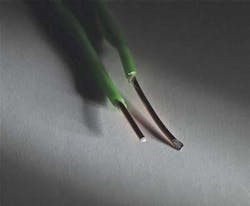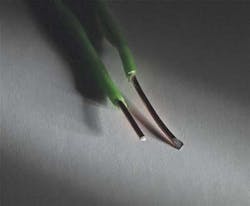Counterfeit cable is getting ugly
The unsightly situation goes beyond the look of twisted pairs and marks on a box, all the way to the courthouse steps.
by Patrick McLaughlin
The scourge of counterfeit cable penetrating the North American structured cabling marketplace is like a many-headed beast. There are several ways in which an unshielded twisted-pair cable (that is the product in our industry that is most commonly counterfeited) can fail to be what its manufacturer claims it is. A brand can be counterfeited, if a counterfeiter puts the name of a recognized cable manufacturer on a product that the manufacturer had nothing to do with producing. Or the product itself can be falsified in multiple ways. It can be manufactured in such a way, or with certain materials, that will cause it to fall short of meeting the performance levels it purports to meet.
Pending lawsuit
One recent claim of counterfeiting has resulted in a lawsuit in which a distributor alleges that a cable manufacturer delivered substandard product that ultimately reached users.
Commodity Cables Inc. (www.commoditycables.com) is the accused. The lawsuit, filed by Anixter (www.anixter.com), alleges that Commodity Cables sold offshore-manufactured cable that fails to meet applicable fire- and flame-resistance standards established by Underwriters Laboratories (UL; www.ul.com) and the National Fire Protection Association (NFPA; www.nfpa.org), even though some of the cables were marked as UL-certified or ETL-verified. According to the lawsuit, Commodity Cables has refused to cooperate in addressing the problem. Commodity Cables' attorney of record had no comment for this article.
Anixter is seeking more than $1 million in damages, as well as punitive damages for false advertising, unfair competition, breach of contract and deceptive trade practices. Randy Mortensen, vice president of marketing for enterprise cabling solutions at Anixter, said, "We believe we are doing our customers and the industry a valuable service by taking a stand against those who threaten the integrity of the supply chain by selling non-compliant product.
"It's an unfortunate fact of life that we have to guard ourselves and our customers from substandard or counterfeit offshore product, but that is the world we live in today," Mortensen continued. He added that, among other measures taken, Anixter has intensified its new vendor setup protocols, established a definitive short list of recognized communications manufacturers it will buy from, and redoubled its efforts to educate customers on the risks involved in buying products of questionable origin and quality.
Trouble between Anixter and Commodity Cables dates back to last year, when Anixter says it inspected the manufacturer's cable in inventory and discovered numerous boxes labeled with what appeared to be fraudulent UL marks and other safety certifications. Out of concern, the distributor sent cable samples to UL for burn testing and as a precautionary measure, implemented a vendor lockout against Commodity Cables to ensure it did not buy or sell any more of the manufacturer's product. Mortensen said the samples sent to UL failed applicable fire-resistance standards.
On December 20, 2010, Anixter communicated to all its customers who had purchased Commodity Cables product from the distributor that it was issuing a broad recall of the brand. Since then, Anixter says it has worked with many customers to remove and replace Commodity Cables' product with compliant cable.
"We are an industry leader, and if there is a doubt about standards compliance of the cable we purchased from Commodity Cables, we are going to err on the side of caution," Mortensen said. He added that while Anixter has taken these steps to stop the flow of this particular brand of cable into the market, it may still be reaching the market through other channels.
David Kiddoo is global business manager with AlphaGary Corporation (www.alphagary.com), which supplies materials for wire and cable, including communications cables. He commented, "Each installer of communications cable should take extra precaution to verify the transmission and the vital fire-safety performance of the cables and materials that they use in each installation project.
"By using cable that has protected markings, such as the holographic labels now required by Underwriters Laboratories, installers will minimize the significant risks that are borne by those who choose to cut corners and install non-compliant cable," Kiddoo continued.
AlphaGary and Anixter are members of CCCA. In August 2010 the association issued a stinging rebuke against the growing epidemic of deficient offshore cable, which can be read at www.cccassoc.org.
Mortensen commented that Anixter's experience with substandard cables emphasizes the need to educate customers about the risks involved with buying low-cost offshore products. He added, "Even though a low price may look attractive initially, products of dubious origin can introduce significant risk due to quality issues and noncompliance with safety and performance standards. When it comes to cable performance and safety, the manufacturing and quality standards adhered to by brand-name companies should matter enormously to buyers and specifiers of structured cabling."
Labeling legitimacy
A couple years ago UL did not necessarily put communications cable into the profile of products that are most often counterfeited. Most often, high-volume, low-priced items like power strips, nightlights and decorative holiday lights are subject to counterfeiting, the organization said. These items carry the UL symbol in a holographic print for exactly that reason—they are the most frequently counterfeited items and counterfeiting a holographic symbol adds a layer of complexity that deters many potential perpetrators.
More recently, UL began recognizing cable as a more-prevalent counterfeit threat and in October 2010 announced it was requiring the use of holographic labels for communications cable. Specifically, UL requires manufacturers of communications cable bearing the UL mark to use holographic labels on the smallest unit container in which the cable is packaged. It required cable manufacturers to destroy all non-holographic labels by that date.
The mark used on cable jackets to designate UL compliance—the letters "UL" either within a circle or in parentheses—has not changed. However, manufacturers are allowed to print the UL mark on a cable jacket only when the accompanying smallest-unit container, such as a reel or a box, also has the UL mark.
UL's requirement for holographic labels on communications cables is the culmination of an effort by the organization that dates back at least until the beginning of 2010 and likely earlier than that. In January 2010 UL issued a bulletin to cable manufacturers that participate in its certification-services programs. UL calls these companies its subscribers. The January 2010 bulletin contained a proposal to revise the requirements of what is known as the Market Integrity Programs, or Follow Up Programs, for multiple cable types. UL then held multiple industry forums in the U.S. and in China during which it gained feedback on the proposal, and also got direct feedback from subscribers not attending the forums. The program UL ultimately put forth included some of the suggested changes that subscribers made.
What the Cat 5e dragged in
Late in the winter of 2011, the cable making up the three main images in this article surfaced. In February Jim Hayes, founder of The Fiber Optic Association (FOA; www.thefoa.org) and VDV Works (www.vdvworks.com), took photos of a box of cable he'd received. Hayes described the situation as follows. "A contractor called me recently and said he had some cable that was hard to install and would not certify. [Later] he called to say they found the problem: The wire was not copper but copper-plated aluminum."
In October 2010 UL began requiring cable manufacturers using the UL name and/or logo to put holographic labels on the smallest-unit container, such as the box. Shown here are the box in which the copper-clad aluminum cable came, and a section of the cable. The box lacks a brand name and also lacks a holographic UL label.
As the photos indicate, there is no apparent brand name of this copper-plated aluminum cable. The counterfeiting that took place in this case is that the cable claimed a level of performance (Category 5e) that it did not meet.
Patrick McLaughlin is chief editor of Cabling Installation & Maintenance.



